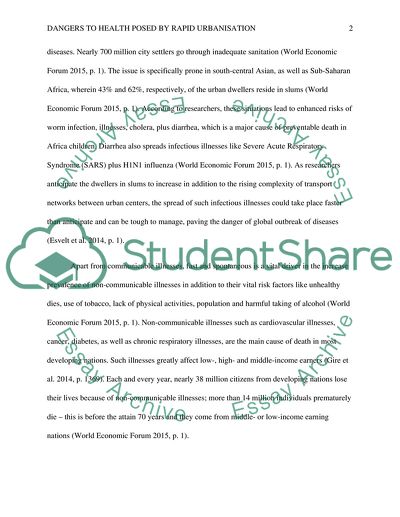Cite this document
(Dangers to Health Posed by Rapid Urbanization Assignment, n.d.)
Dangers to Health Posed by Rapid Urbanization Assignment. Retrieved from https://studentshare.org/environmental-studies/1881714-with-reference-to-specific-examples-from-the-developing-world-analyse-some-of-the-dangers-to-health-posed-by-rapid-urbanisation-what-solutions-if-any-are-there-to-the-problems-caused-and-how-realistic-are-they
Dangers to Health Posed by Rapid Urbanization Assignment. Retrieved from https://studentshare.org/environmental-studies/1881714-with-reference-to-specific-examples-from-the-developing-world-analyse-some-of-the-dangers-to-health-posed-by-rapid-urbanisation-what-solutions-if-any-are-there-to-the-problems-caused-and-how-realistic-are-they
(Dangers to Health Posed by Rapid Urbanization Assignment)
Dangers to Health Posed by Rapid Urbanization Assignment. https://studentshare.org/environmental-studies/1881714-with-reference-to-specific-examples-from-the-developing-world-analyse-some-of-the-dangers-to-health-posed-by-rapid-urbanisation-what-solutions-if-any-are-there-to-the-problems-caused-and-how-realistic-are-they.
Dangers to Health Posed by Rapid Urbanization Assignment. https://studentshare.org/environmental-studies/1881714-with-reference-to-specific-examples-from-the-developing-world-analyse-some-of-the-dangers-to-health-posed-by-rapid-urbanisation-what-solutions-if-any-are-there-to-the-problems-caused-and-how-realistic-are-they.
“Dangers to Health Posed by Rapid Urbanization Assignment”, n.d. https://studentshare.org/environmental-studies/1881714-with-reference-to-specific-examples-from-the-developing-world-analyse-some-of-the-dangers-to-health-posed-by-rapid-urbanisation-what-solutions-if-any-are-there-to-the-problems-caused-and-how-realistic-are-they.


